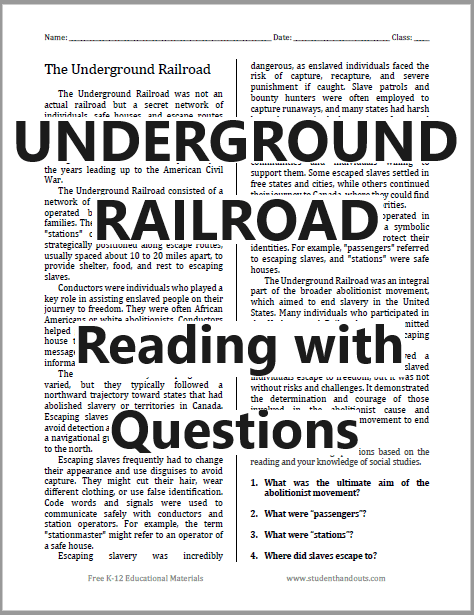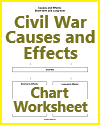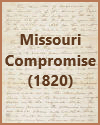| Underground Railroad Reading with Questions |
|---|
| www.studenthandouts.com ↣ U.S. History ↣ National and Sectional Conflict ↣ Worksheets |
 |
    |
|
Click here to print. Answers: (1) end of slavery, (2) escaped slaves on the Underground Railroad, (3) safe houses along the Underground Railraod, and (4) northern states and Canada. The Underground Railroad was not an actual railroad but a secret network of individuals, safe houses, and escape routes used by enslaved African Americans to escape from slavery in the southern United States to freedom in the North or in Canada. It operated during the 18th and 19th centuries, primarily in the years leading up to the American Civil War. The Underground Railroad consisted of a network of safe houses and stations, often operated by sympathetic individuals or families. These locations were also known as "stations" or "depots." Safe houses were strategically positioned along escape routes, usually spaced about 10 to 20 miles apart, to provide shelter, food, and rest to escaping slaves. Conductors were individuals who played a key role in assisting enslaved people on their journey to freedom. They were often African Americans or white abolitionists. Conductors helped guide escaping slaves from one safe house to another, sometimes using coded messages and signals to communicate information about routes and conditions. The routes taken by escaping slaves varied, but they typically followed a northward trajectory toward states that had abolished slavery or territories in Canada. Escaping slaves often traveled at night to avoid detection and relied on the North Star as a navigational guide because it always points to the north. Escaping slaves frequently had to change their appearance and use disguises to avoid capture. They might cut their hair, wear different clothing, or use false identification. Code words and signals were used to communicate safely with conductors and station operators. For example, the term "stationmaster" might refer to an operator of a safe house. Escaping slavery was incredibly dangerous, as enslaved individuals faced the risk of capture, recapture, and severe punishment if caught. Slave patrols and bounty hunters were often employed to capture runaways, and many states had harsh laws that required the return of escaped slaves to their owners. Once escaping slaves reached their ultimate destinations, they often found communities and individuals willing to support them. Some escaped slaves settled in free states and cities, while others continued their journey to Canada, where they could find safety from the reach of U.S. authorities. The Underground Railroad operated in secrecy, and participants used a symbolic language to communicate and protect their identities. For example, "passengers" referred to escaping slaves, and "stations" were safe houses. The Underground Railroad was an integral part of the broader abolitionist movement, which aimed to end slavery in the United States. Many individuals who participated in the Underground Railroad were committed abolitionists who viewed helping escaping slaves as a moral imperative. The Underground Railroad played a crucial role in helping thousands of enslaved individuals escape to freedom, but it was not without risks and challenges. It demonstrated the determination and courage of those involved in the abolitionist cause and contributed to the broader movement to end slavery in the United States. Answer the following questions based on the reading and your knowledge of social studies. 1. What was the ultimate aim of the abolitionist movement? 2. What were "passengers"? 3. What were "stations"? 4. Where did slaves escape to? |
| www.studenthandouts.com ↣ U.S. History ↣ National and Sectional Conflict ↣ Worksheets |








